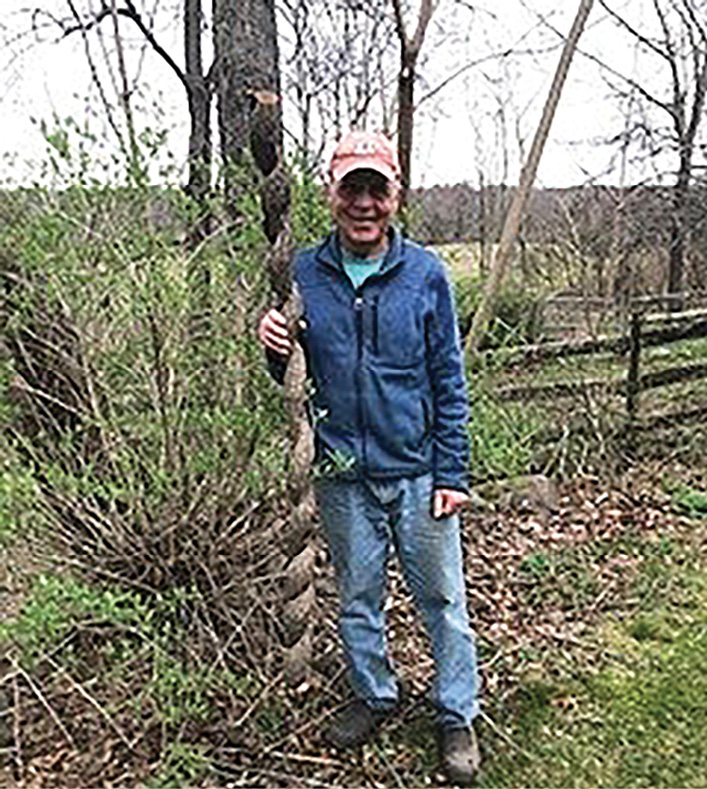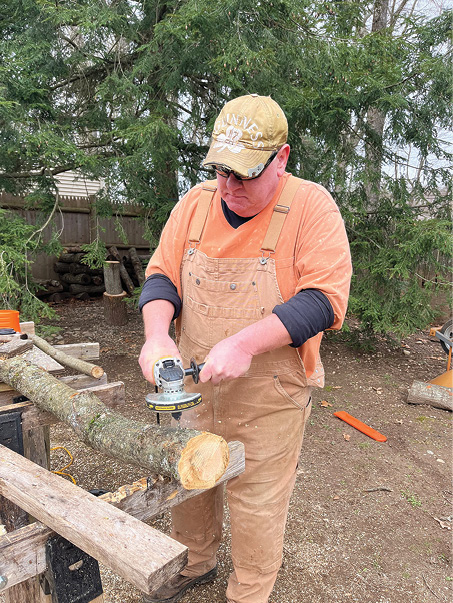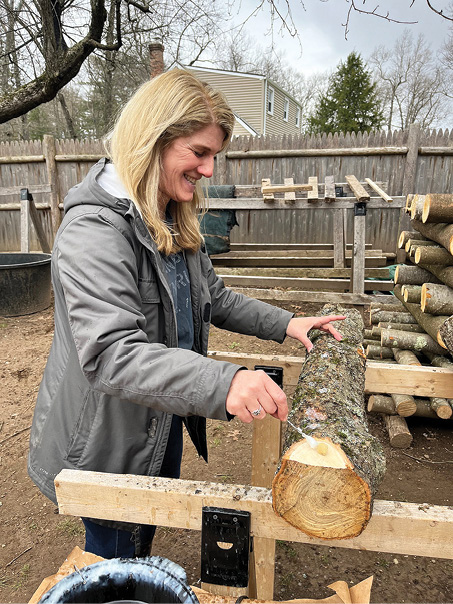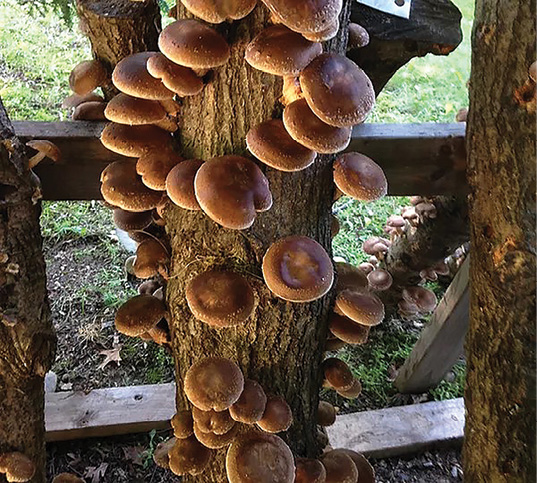Rain doesn’t deter farmers
April showers are raining down as I write this—actually, another downpour today—and you may think this dampens activity at the farm but you would be mistaken! On the land, Farmer Joe has begun to reassemble his crew, the greenhouses are being converted from winter greens to summer beans (and more) and CSA sales remain open (but not for much longer, so sign-up now).
Our trail maintenance activity is kicking into high gear, with lots of repairs needed after the winter storms. Thank goodness for volunteers. Meanwhile, the Friends’ summer events are in the planning stages, while Fresh Access partners are anticipating the first distributions in June. Read on to learn more and mark your calendars.
Submitted by Jenny Emery
CSA shares still available!
June 11 launches another season of the Holcomb Farm CSA, with 20 weeks of fresh produce for you to pick up at your convenience, Tuesday through Saturday at the Holcomb Farm CSA barn on Simsbury Road. Bring your kids and show them where their veggies come from. Eat local while you can. Help keep these fields farmed and fruitful, free of chemicals and pesticides. Experience the flavor of Holcomb Farm.
CSA stands for Community Supported Agriculture—a smart way for consumers to buy local, seasonal food directly from a farmer. It’s cost-effective, it’s delicious and, at Holcomb Farm, it’s free of chemicals. Full shares (more than enough for a family) are $38.50/week and half shares (more than enough for a couple) are $20/week when paid by cash or check. Get yours, while they last, at holcombfarm.org/joincsa
Thanks to Lost Acres Vineyard
Before we look to our exciting summer of events, let’s look back with thanks for the great Spring Farmers’ Market at the Vineyard, where the Friends of Holcomb Farm joined many local agricultural partners in providing local products for our friends’ and neighbors’ various spring holiday tables. Fresh greens from our greenhouses taste that much better in late-March New England.

Plant Sale & Mushroom Log Clinic
It’s May, and that means the greenhouses are full of beans and the barn is readying for the annual plant sales. The first, May 10 and 11, just in time for Mother’s Day, will include cold-tolerant plants including flowers, herbs, kale and more. The second, May 24 and 25, offers all of those that remain, plus warmer weather plants, like tomatoes, peppers and melons. The Barn Farm Store will be open from 10 a.m. to 4 p.m. on all four days, but don’t wait until the last minute, as we could sell out of some of your favorites.
New this year: Granby’s own Andy Griffin of RMS Growers will conduct make-your-own shiitake mushroom log clinics at the barn during the plant sales on Saturdays, May 11 and May 25, from 12 to 2 p.m. This experience includes a 30-minute presentation on the process and then a hands-on workshop in which each registrant will “drill and fill” their own log to take home. With good management, these logs will produce fresh shiitakes to harvest for up to several years. Griffin has been using oak logs sourced locally to grow his shiitakes, which we sell in the Farm Store; they have become so popular we can barely keep them in stock.
The process of inoculating the logs with mushroom spawn may seem simple, but the quality of the log and spawn on the front end, and moisture management of the log over the long term, is the key to your success in harvesting pounds of fresh shiitakes for months and years to come. That is where Griffin’s expertise comes in. And, Andy is donating all proceeds after costs to the Fresh Access program, which provides food we grow to people in need, free-of-charge.
Pre-registration is strongly encouraged. Go to holcombfarm.org to secure your spot for $40. With the right nurturing, the value of the mushrooms you will harvest from your log should far exceed the cost of the clinic.
Tackling invasives on the trail

Long-time board member and stewardship committee co-chair Eric Lukingbeal tells us more about the ongoing work involved in the development and maintenance of the Holcomb Tree Trail, making it the inviting public resource that it is.
Readers who have been to the Holcomb Farm in West Granby may have seen people carrying simple tools like shovels and saws, trudging up the hills in all sorts of weather. Readers may have wondered who these people are, and what they are doing. Answering these questions requires a bit of background.
The mission of the 30-year-old nonprofit Friends of Holcomb Farm is brief—“To preserve, promote and utilize an historic New England working farm.” In October 2022, the town, which came to own the farm through benefactors Tudor and Laura Holcomb, conveyed a conservation easement to the Granby Land Trust, which prohibited all development or subdivision on 277 of the Farm’s 312 acres. At the same time, the town entered a new lease and use agreement with the Friends of Holcomb Farm. One of the terms of the lease calls on the Friends to “manage the open space, fields, meadows and woodlands, including the development and maintenance of an arboretum.”
The Friends’ management responsibilities are carried out by a Stewardship Committee of the board, plus volunteers. The first 16 trees in the arboretum were planted in October 2018. Now, more than 100 trees have been planted, and there are almost three miles of mowed paths around the trees and fields. These paths are the Holcomb Tree Trail.
Planting, watering, mulching, installing deer protection and caring for the trees—not to mention labeling them and developing educational plaques—is all done by volunteers. But the most time-consuming work is controlling invasive plants. Most folks who have lived in New England for a while know that the single biggest change to the rural landscape is the dramatic increase in invasive plants.
Invasive plants are successful in outcompeting natives for several reasons. First, they were brought and spread by people who thought they were pretty or useful. Japanese knotweed, multiflora rose, burning bush, barberry, and Oriental bittersweet all served decorative ends. Autumn and Russian olive grew quickly and made impenetrable hedgerows to house livestock. State agencies even gave it away free to farmers. The second reason invasives succeeded is that they had no natural enemies here. It is a rare Granby house lot that does not have at least some invasive plants.
The result is that much of New England is infested with invasives. At Holcomb Farm, the three most prevalent invasives are Oriental bittersweet, multiflora rose, and Japanese barberry. The bittersweet grows fast, climbs trees and even strangles smaller ones. Bittersweet can take down very large trees if weighed down by ice and snow. The vines can reach 60 feet or more and can be several inches thick. Multiflora rose has pretty pink and white blooms, but quickly becomes a nine-foot-high mass of thorns in a few years. Barberry has attractive fall foliage, but also provides ideal habitat for mice, the favorite target of Lyme disease-carrying black legged ticks. Tick density is highest in barberry thickets.
Back to our original question: the people readers may see carrying tools are engaged in controlling invasives. Mechanical means are used where possible. Chemical sprays are not used. Volunteers use saws, axes, loppers, clippers, shovels, pry bars, weed whackers and power mowers. Sometimes, several volunteers are needed to pull bittersweet vines out of trees, releasing the trees from vines which will eventually kill them. Many of the scenic Eastern red cedars that dot the Holcomb landscape were once infested with vines.
For really big infestations, the Friends have hired a contractor with specialized invasive removal equipment to take down infested trees in hedgerows. The work is endless, as the invasives are well-established here, and the birds spread the seeds. Still, most of the work is done by volunteers using simple tools. The goal is to keep the fields and trails clear and to gradually expose the historic stone walls separating the fields. Some readers may have noticed recently cleared stone walls, visible from Simsbury Road.
Our volunteer efforts have gotten better organized over the years. We now have a volunteer corps of 30 or so folks. We have monthly workdays on the third Saturday morning of the month, for two hours, weather dependent. Usually, eight to 12 volunteers show up. Volunteers must be prepared for ticks and poison ivy, as both are common year-round. Smaller projects involving one or two people are also undertaken.
We can always use more volunteers. Please drop a note to kadrle@holcombfarm.org if you would like to be added to our stewardship volunteer list. You will receive emails about workdays and can show up if interested and available.
SAVE THE DATES
May 10–11 and 24–25: 10 a.m.–4 p.m. Plant sales at the Holcomb Farm CSA and Farm Store Barn
May 11 and 25: 12–2 p.m. Mushroom Log Clinic at the Holcomb Farm CSA and Farm Store Barn. Register at holcombfarm.org
May 19: 12–1 p.m. Friends of Holcomb Farm Annual Members Meeting at the Holcomb Farm North Barn
May 20: 7 p.m. Friends’ State of the Farm Presentation to Board of Selectmen
June 1 (rain date June 2): 10 a.m. Trails Day Hike at the Holcomb Tree Trail
June 11: 10 a.m.–6 p.m. CSA launch and Farm Store opening
Aug. 24: First Ever Holcomb Hoe-Down Community Event at the North Barn



